BY LETTER
Savastos System
Galactography > Regions of Space > Middle Regions/Hinter-regions
Galactography > Places and Locales
Galactography > Systems and Worlds > Systems & Worlds S - T
Galactography > Places and Locales
Galactography > Systems and Worlds > Systems & Worlds S - T
Star system controlled by the Caretaker Gods, Zoeific Biopolity, and the Solar Dominion. | |
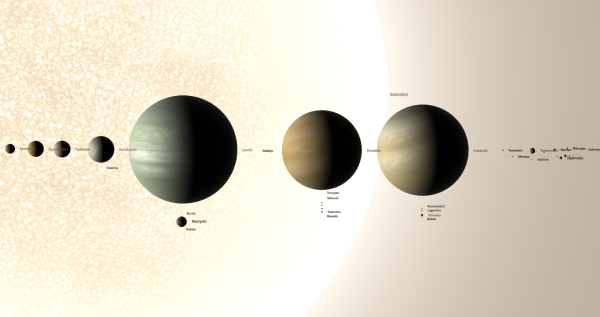 Image from Dangerous Safety and The Astronomer | |
| Home of the Garden World of Macrystis | |
Savastos System - Data Panel | |
| System | Name: Savastos Location: near HIP 15941/HD 20898 (03h 25m 16.26 and +60° 29` 01.4) - Distance from Sol: 2050 ly, Reached 5393 -Constellation from Earth: Camelopardalis |
|---|---|
| Star | Names: Savastos, YTS 32050-2-331-1 Physical characteristics: - Mass: 1.008 M - Radius: 0.988 R - Luminosity: 0.96 L - Temperature: surface temperature: 5775 K - Spectral type: G2V - Age: 3.63 BYA |
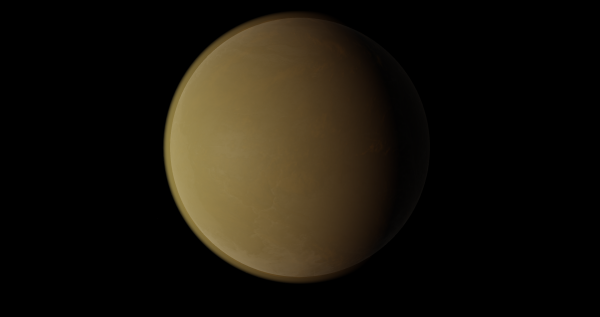 Image from Dangerous Safety and The Astronomer |
| First Planet | Name: Fasetuvastas Orbital characteristics: - Semi-major axis: 0.141 AU - Orbital period: 19.26 standard days - Eccentricity: .208 Physical characteristics: - Type: Videntian SulfoTerrestrial LapiMinervan Inundic Tundral IgneoGaian IgneoThalassic - Mass: 0.629 Earths - Radius: 0.848 Earths - Density: 5687 kg/m^3 - Mean surface acceleration: 0.876 G - Rotational period: 38.52 days - Albedo (Bond): 0.28 - Obliquity: 3.6 deg - Insolation: 48.29 Earths Fasetuvastas remains a world of hellish climate for earthly lifeforms. The brown haze of sulfur compounds and CO2 which covers the planet hides a baking, crushing landscape with ever-shifting lava flows under the blast-oven heat. Tidally locked to the primary star, Savastos, the planet is covered in a permanent ocean of molten magma on its day side, and a thin, ever shifting crust of temporarily hardened magma on its night side. Though it remains one of the few rocky/terran worlds of significant size in the system, its surface has stayed unapproachable for any but the most hardened probes. The sulfurous haze and outgassing of CO2 enshroud the grayish red surface from full view, but orbital and Aerial infrared photography of the lava flows has remained popular for more intrepid visitors allowed by the caretaker collective. |
|---|
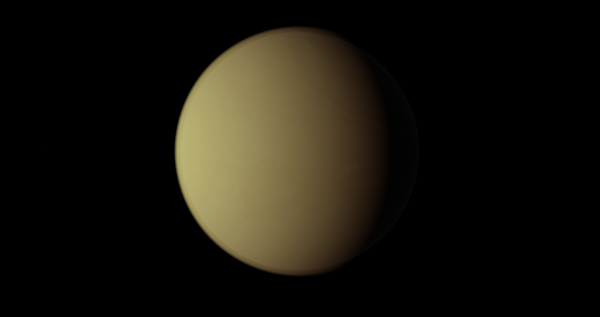 Image from Dangerous Safety and The Astronomer |
| Second Planet | Name: Suvakestas Orbital characteristics: - Semi-major axis: 0.407 AU - Orbital period: 94.46 standard days - Eccentricity: 0.033 Physical characteristics: - Type: Stilbonian SulfoTerrestrial LapiMinervan CapnoCytherean - Mass: 3.262 Earths - Radius: 1.390 Earths - Density: 6,696 kg/m^3 - Mean surface acceleration: 1.691 G - Rotation period: inf - Obliquity: n/a - Albedo: 0.33 - Insolation: 5.795 Earths A super-earth planet with an orange and tan haze covered a hostile 'ocean' of supercitical carbon dioxide, Suvakestas has remained generally un-colonized by modosophonts, though a small number of macrystian polities live in orbit. The caretaker swarm has begun constructing mining installations in the crust and buried servers for hylo-biogeocomputing while they begin to disassemble the planet , but have no known installations on the surface of Suvakestas itself. |
|---|
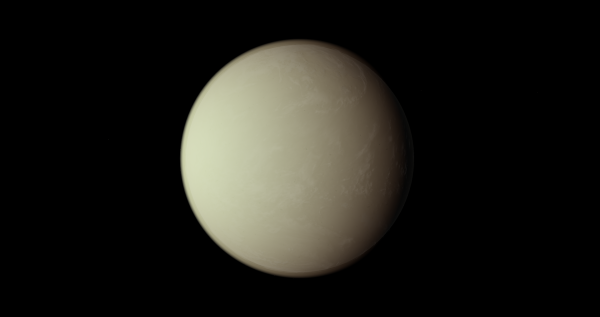 Image from Dangerous Safety and The Astronomer |
| 3rd planet | Name: Tadestas Orbital characteristics: - Semi-major axis: 0.591 AU - Orbital period: 165.3 days - Eccentricity: 0.0041 Physical characteristics: - Type: AcidiTerrestrial LapiMinervan AquaCytherean - Mass: 3.859 Earths - Radius: 1.466 Earths - Density: 6752 kg/m^3 - Mean surface acceleration: 1.798 G - Rotation period: 21.84 standard days - Obliquity: 17 degrees - Albedo (Bond) = 0.76 - Insolation: 2.749 Earths Though the glinting white ball of Tadestas seems inviting from orbit, this Rocky terrestrial world 3.8x the mass of earth hides an unforgiving ocean. For less capable civilizations, the great irony of savastos system would be the immense oceans of water available on the 2nd and third planets, but which would remain largely inaccessible short of planetary mining megastructures. The world is covered in tan, brown and white clouds of sulfuric acid above a hot supercritical ocean of liquid water which gradually transitions from gas to liquid to solid. There, hundreds of kilometers below (250-300km deep), a layer of solid ice VII, X, and XI, lie near the rocky crust at the bottom. The caretaker swarm has constructed sunshades in orbit , in which some natively designed clades of vecs live. Little to no mining has been attempted due to the pressures, beyond harvesting water from the atmosphere. The caretakers have begun to seed forms of extremophile life in the oceans but project that the necessary nutrients will be insufficient for centuries to come. |
|---|
 Image from Dangerous Safety and The Astronomer |
| 4th planet | Name: Relukestis Orbital characteristics: - Semi-major axis: 0.825 AU - Orbital period: 272.8 days - Eccentricity: 0.0053 Physical characteristics: - Type: Skolian HydroNeptunian CereYdratian AquaCytherean - Mass: 6.194 Earths - Radius: 1.922 Earths - Density: 2.424 kg/m^3 - Mean surface acceleration: 1.056 G - Rotation period: 22.28 hours - Obliquity: 59.2 deg - Albedo (Bond): 0.56 - Insolation: 1.409 Earths Much like the inner planet, Tadestas, Relukestis is a less extreme ocean world covered in boiling water. Despite being a Neptunian, its atmosphere is dominated by water at all depths, transitioning to supercritical fluid after several hundred kilometers. This steadily increasing pressure continues all the way down to the layers of Ice 10 above the partially molten silicate surface at the bottom. The planet has a tilted axis much like the planet Uranus in the Sol system but to a lesser degree. The atmosphere is composed mostly of hydrogen, helium, methane, ammonia, and water vapor, with clouds of steam condensing above the surface ocean and extending further into the sky, cooling significantly with their height. |
|---|
 Image from Dangerous Safety and The Astronomer | |
| A distant view of macrystis and Lontis, taken by the first exploratory probes | |
| 5th planet | Name: Lontis Orbital characteristics: - Semi-major axis: 1.239 AU - Orbital period: 501.6 days - Eccentricity: 0.0137 Physical characteristics: - Type: Mesobiotic HydroJovian HydrogeoBarian - Mass: 141 Earths - Radius: 9.771 Earths - Density: 833 kg/m^3 - Mean surface acceleration: 1.2 G - Rotation period: 10.21 hours - Obliquity: 0.346 degrees - Albedo: 0.71 - Insolation: 0.625 Earths Lontis is the largest planet in the star system with high sulfur compounds, high water content and organic compounds in its upper atmosphere. Below this, layers of Metallic hydrogen under high pressure surround a rocky core, like many jovian planets. The gas giant is a life bearing world with microscopic life in the atmosphere. Though life on Lontis may have originated on Macrystis and been transferred via unknown mechanisms, proof remains inconclusive, as fossils cannot form and the genetic differences between Macrystis and Lontis life are radical enough that the answer is inconclusive. In the current era since colonization, Outside of minor gas mining operations by the caretakers for constructing their orbital platforms and terrariums, they have left the skies of Lontis alone. |
|---|---|
| Moon 5a | Name: Valfrutis Orbital characteristics: - Semi-major axis: 151.1 Mm - Orbital period: 13.74 hours Physical characteristics: - Type: Videntian Terrestrial Lapidian Apnean Satellite - Mass: 5.17E-07 Earths - Radius: 76.5 km |
| Moon 5b | Name: Burtis Orbital characteristics: - Semi-major axis: 192,240 Mm - Orbital period: 19.62 hours Physical characteristics: - Type: Videntian Terrestrial LapiMinervan Apean Satellite - Mass: 1.14E-04 Earths - Radius: 374 km - Albedo: 0.46 |
| Moon 5c | Name: Macrystis Orbital characteristics: - Semi-major axis: 508.8 Mm - Orbital period: 3.51 days Physical characteristics: - Type: Videntian Macrobiotic HydroTerrestrial LapiRhean Lacustrine Tundral AquaGaian Satellite - Mass: 0.813 earths - Radius: 0.935 Earths -surface acc: 0.93G - Albedo: 0.39 |
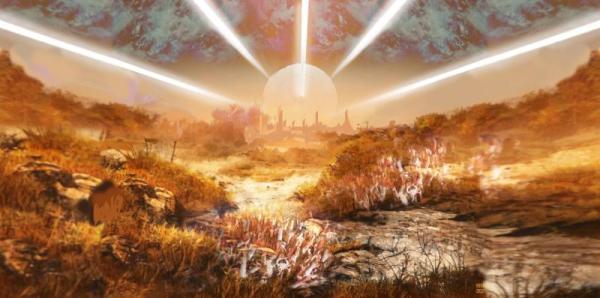 Image from Worldtree | |
| A view of transplanted life inside an O'Neil cylinder terrarium orbiting Lontis | |
Macrystis is a Garden world, the largest moon of Lontis, a temperate gas giant. Macrystis has about 35% ocean coverage, much of it in an ocean on the side opposite from Lontis, along with a few shallower oceans on the Lontis-facing side. Most of the habitable land is tundra, as well as significant savanna, though the polar highlands can experience winters cold enough for carbon dioxide snow. Along continental margins, life thrives in temperate areas, while there are only tiny patches of tropical climates below sea level within tectonic rifts. Macrystis's orbital period and day length are identical at 3.51 Terran days, as it is tidally locked to Lontis. Climate is subject to significant daily temperature swings, in some areas resulting in a daily freeze-thaw cycle, and much of the world experiences highly seasonal rainfall.
Macrystian life originated over 3.1 billion years ago, and macrobiotic life first evolved about 545 million years ago. Microbial and macroscopic colonial life with a common ancestry to Macrystian life exists on Lontis as well. While it is unknown whether Macrystian life reached Lontis via natural panspermia or was placed there by ancient xenosophonts, Lontis's trojan planetoids are unusually carbonaceous, suggesting that Lontis could have been naturally enriched in carbon via impacts billions of years ago, which would have provided a route for life to get a foothold on arrival.
More information
| Moon 5d | Name: Posbitis Orbital characteristics: - Semi-major axis: 3.47 Gm - Orbital period: 62.72 days Physical characteristics: - Type: Posbitis Videntian Terrestrial Lapidian Apnean Satellite - Mass: 7.71E-07 Earths - Radius: 65.0 km - Albedo: 0.47 |
|---|
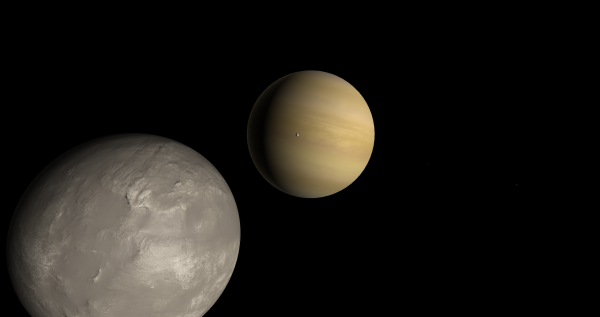 Image from Dangerous Safety and The Astronomer | |
| Huraltis and one of its moons, Delkystis | |
| 6th planet | Name: Huraltis Orbital characteristics: - Semi-major axis: 4.671 AU - Orbital period: 10.05 days - Eccentricity: 0.0114 Physical characteristics: - Type: SulfaJovian HydrogeoBarian - Mass: 33.80 Earths - Radius: 7.172 Earths - Density: 505 kg/m^3 - Mean surface acceleration: 0.565 G - Rotation period: 15 hours - Obliquity: 10.6 deg - Albedo: 0.35 -Insolation: 0.044 Earths As the 3rd largest planet in the star system, Huraltis is a massive gas giant with high quantities of sulfur compounds in its upper atmosphere. Beneath its clouds are layers metallic hydrogen under high pressure with a rocky core, like many jovian planets. The world is used primarily for mining by the Caretaker Gods. |
|---|
 Image from Dangerous Safety and The Astronomer |
| 7th planet | Name: Listastis Orbital characteristics: - Semi-major axis: 7.928 AU - Orbital period: 22.23 years - Eccentricity: 0.0036 Physical characteristics: - Type: SulfaJovian HydrogeoBarian - Mass: 56.69 Earths - Radius: 8.194 Earths - Density: 568 kg/m^3 - Mean surface acceleration: 0.717 G - Rotation period: 13.9 hours - Obliquity: 18.7 deg - Albedo: 0.41 -Insolation: 0.015 Earth's Listastis is a massive gas giant with high quantities of sulfur compounds in its atmosphere and a Metallic hydrogen mantle under high pressure with a rocky core, like many jovian planets. In addition to being the 2nd largest planet, this planet and its moons form the primary population center of the Savastos system for the vast majority of non-macrystian life. Thousands of orbital habitats and transapient nodes have been built on the moons and in orbit to house the comparatively small immigrated terragen populations in the past 500-1000 years. For most of the past four thousand years, the inner system remained locked by the caretaker gods from terragens not descended from Macrystian genetics, but the inner system has opened up marginally . The Transapient nodes of the Zoerific biopolity and solar dominion archai orbit here as well, while swarms of gas giant-colonizing terraforming balloons mine the atmosphere of Listastis for material. Though the vast majority of transportation into the system and within it use a lightways network, the largest shipyard in the system grows in orbit. |
|---|
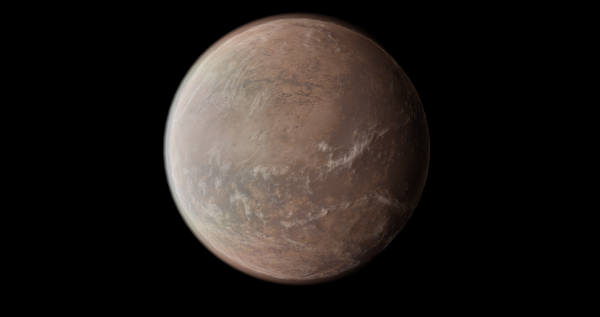 Image from Dangerous Safety and The Astronomer | |
| A view of Tigonustas from orbit | |
| 8th planet | Name: Tigonustas Orbital characteristics: - Semi-major axis: 18.29 AU - Orbital period: 77.9 years - Eccentricity: 0.091 Physical characteristics: - Type: Terrestrial CereRhean Estuarine Tundral AzoGaian - Mass: 0.0747 Earths - Radius: 0.523 Earths - Density: 2.879 kg/m^3 - Mean surface acceleration: 0.268 G - Rotation period: 18.4 hours - Obliquity: 26.2 degrees - Albedo: 0.41 - Insolation: 0.0029x Earth's |
|---|---|
| 8a moon | Name: Nakitas Orbital characteristics: - Semi-major axis: 86.32 Mm - Orbital period: 10.68 days - Eccentricity: 0.0905 Physical characteristics: - Type: Terrestrial GeliRhean Apnean Satellite - Mass: 7.57E-05 Earths - Radius: 413 km - Density: 1534 kg/m^3 - Mean surface acceleration: 0.018 G - Rotation period: 10.69 - Obliquity: 26.2 degrees - Albedo: 0.3 - Insolation: 0.003 |
Related Articles
Appears in Topics
Development Notes
Text by Dangerous Safety
from the original short article by Steve Bowers, 07 December 2011 Short entry and illustrations Originally created by Anders Sandberg and Steve Bowers Expanded 2020-present (2024) By Banelord, Salty, TSSL, Jay the Tardupod, Schwefel Kamm, Worldtree, DocViviLeandra, Dangerous Safety, Destructules, The Astronomer, Everything4404, Cube67, Andonis, Oofles, MajGenrelativity, Teris, Dinomaster337, Cynognathus823, Nikolai- Prince of Denmark, Not Applicable, A Human, et al
Initially published on 10 February 2024.
Planet descriptions added April 8, 2025
from the original short article by Steve Bowers, 07 December 2011 Short entry and illustrations Originally created by Anders Sandberg and Steve Bowers Expanded 2020-present (2024) By Banelord, Salty, TSSL, Jay the Tardupod, Schwefel Kamm, Worldtree, DocViviLeandra, Dangerous Safety, Destructules, The Astronomer, Everything4404, Cube67, Andonis, Oofles, MajGenrelativity, Teris, Dinomaster337, Cynognathus823, Nikolai- Prince of Denmark, Not Applicable, A Human, et al
Initially published on 10 February 2024.
Planet descriptions added April 8, 2025
Additional Information
editor's note: The moon of Lontis, Burtis, was named after the 1962 soviet film Planeta Bur, which influenced some early designs for macrystis- hence the 19.62 hour period






